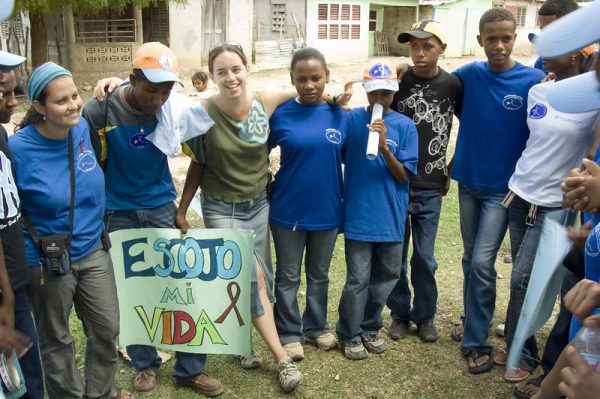
Volunteers work with youth to create posters for an HIV awareness campaign. Photo by Peace Corps via Flickr.
Service-learning is an extremely high-impact educational practice. Research shows that it increases students’ social responsibility and civic-mindedness, awareness of stereotypes, tolerance for diversity, and commitment to continued civic engagement and development of multicultural skills like empathy, patience, reciprocity and respect. Teachers may assume the benefits of service-learning come from relatively advantaged students reducing their prejudices through contact with relatively disadvantaged service populations. This is only part of the story, though. New research shows that students from lower socioeconomic backgrounds are actually more attuned to structural — instead of individual — explanations of inequality during service-learning.
Sociologists Molly Clever and Karen S. Miller analyzed their students’ written reflections on a service-learning project focused on food insecurity. The students came from Introduction to Social Justice and Social Problems courses at a small, private, liberal arts college in rural Appalachia. They were predominantly white, but varied in their social class background. The service-learning project involved touring a local food bank and then planning, preparing, serving, and dining at a meal with their food-insecure neighbors.
Clever and Miller analyzed their students’ written reflections before and after the experience, and compared the learning processes of students from low socioeconomic status (SES) to their middle- and high-SES peers. They found that low-SES students focused more on the impact their service had on others rather than on themselves. They were also more attuned to what the people they were serving were learning and to systemic explanations for inequality. These differences suggest that the common way of thinking about the benefits of service-learning — that is, as outcomes produced through prejudice reduction — fails to capture what low-SES students are getting out of the experience.
Based on these findings, Clever and Miller offer several suggestions to improve service-learning pedagogy for students of diverse socioeconomic backgrounds. Instructors should:
- Include essay prompts that encourage students to engage more critically with their assumptions about the service population.
- Create more opportunities for students to directly engage with the service population.
- Assess outcomes other than prejudice reduction, since it isn’t the most important learning outcome for all students.
- Be thoughtful about how the relationship between students’ social identities and service site contexts could impact the student learning experience.
Molly Clever and Karen S. Miller. 2019. ““I Understand What They’re Going through”: How Socioeconomic Background Shapes the Student Service-learning Experience.” Teaching Sociology. 47(3) :204-218.
